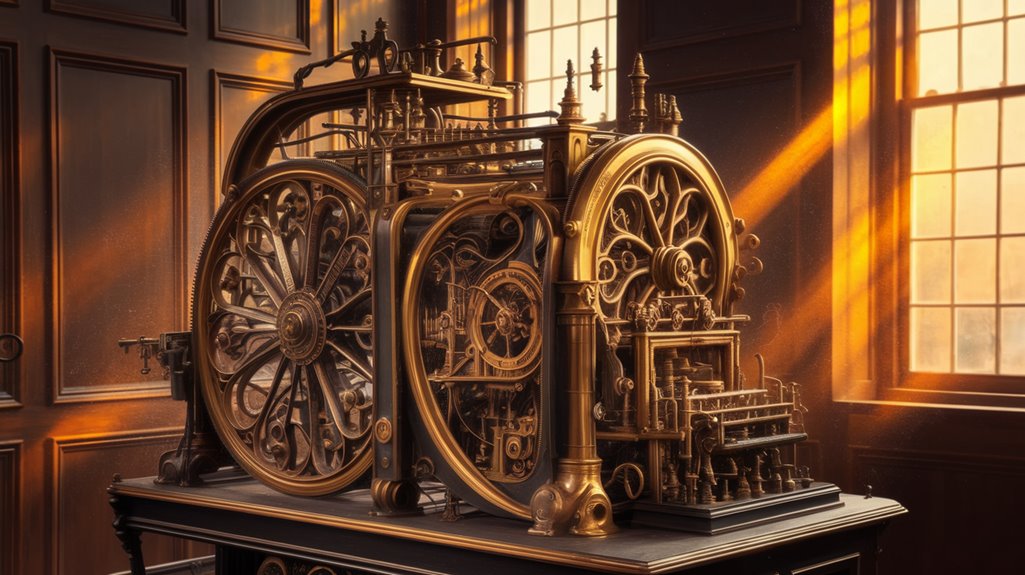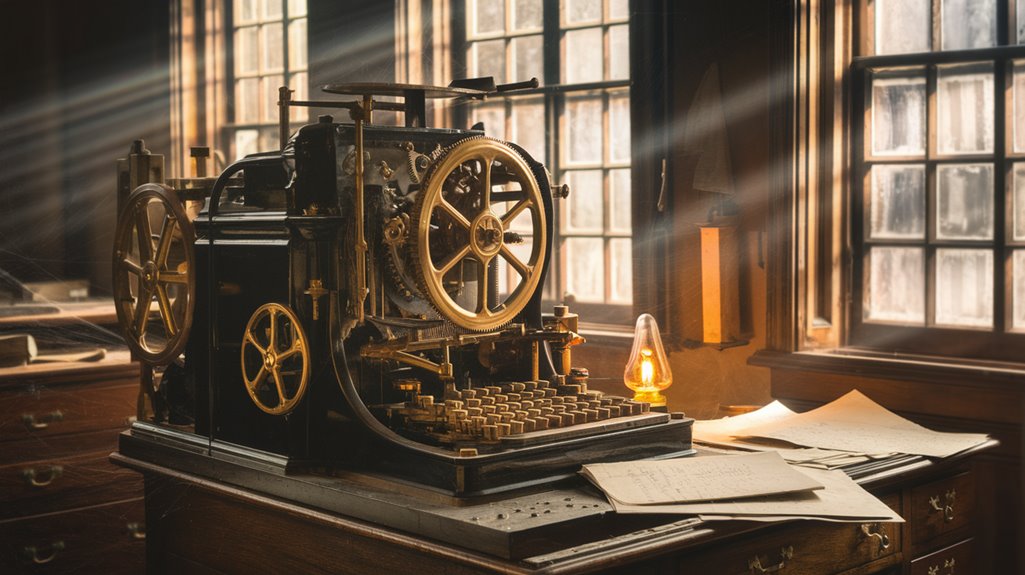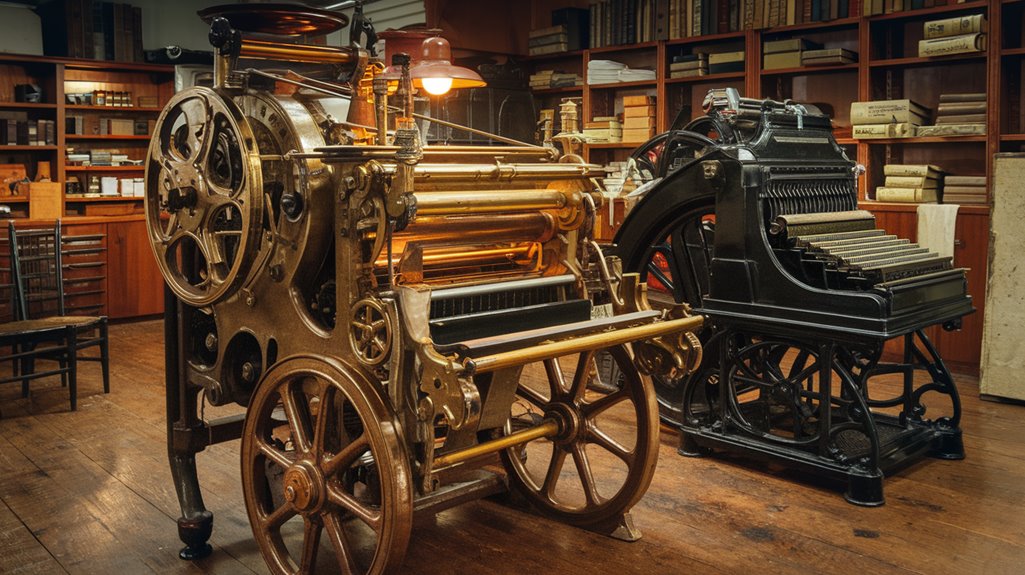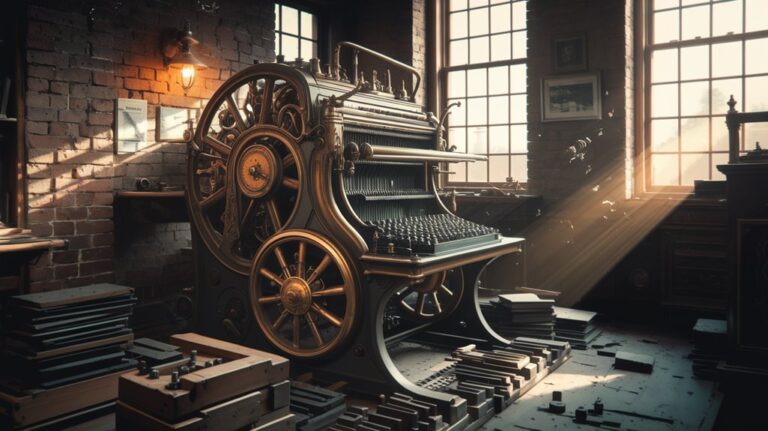Mark Twain’s Folly: The Typesetting Machine That Bankrupted Him
Did you know that $300,000 in 1894 would be worth over $10 million today? That's the staggering sum Mark Twain lost on a single failed investment: the Paige Compositor typesetting machine. You'll find it ironic that one of America's most successful authors nearly lost everything by backing the wrong technology in the printing industry. His journey from literary genius to bankruptcy, and back again, offers valuable lessons about innovation, obsession, and the dangers of betting big on unproven ventures.
The Dream of Automated Typesetting

While hand-setting type had been the norm for centuries, the dream of automated typesetting began taking shape in the 19th century with the invention of hot metal typesetting machines like the Linotype.
Operators used a keyboard system to rapidly produce text, making the California Job Case obsolete.
You'll find that this automated innovation revolutionized the printing industry by replacing the tedious process of setting individual letters with a keyboard-operated system that could cast entire lines of type at once.
The typesetting evolution continued through the mid-20th century, when Bafour, Blanchard, and Raymond patented the first electronic computing system in 1954.
The development of this technology was significantly influenced by IBM's Generalized Markup Language, which became a foundational element for future typesetting systems.
As technology advanced, you'd see the emergence of phototypesetting machines, which brought programmable features and faster digital communications.
This progression ultimately led to sophisticated systems capable of multicolumn layouts, automatic indexing, and even spell-checking, transforming the landscape of print production forever.
The Fatal Investment: Inside the Paige Machine
Innovation often comes at a steep price, as Mark Twain discovered through his ruinous investment in the Paige Compositor. This technological innovation, patented in 1874, was a marvel of complexity with 18,000 intricate parts, including bearings, cams, and springs. Twain supported the project with monthly payments of $4,000 during development.
Ottmar Merganthaler's Linotype machine succeeded where the Compositor failed. You'd be amazed to learn that while the machine could set 12,000 ems per hour and featured an automatic justifier, its complexity proved to be its downfall. The inventor's compulsive need to improve the design led to constant delays and adjustments.
Despite a successful trial at the Chicago Herald in 1894, only six production machines were ever built, each costing a staggering $15,000. The investment devastated both Twain, who lost $180,000 (nearly $7 million today), and Paige himself, who died penniless in 1917.
A Battle of Technologies: Paige vs. Linotype
The technological duel between the Paige Compositor and the Linotype machine marked one of printing history's most fascinating rivalries.
In the battle for technological evolution, Paige's complex machine mimicked human typesetting with 18,000 parts, while Linotype opted for a simpler, more robust design.
You'd find Paige's innovation impressive: it could match twelve hand compositors' speed and outperform thirty-two Linotype machines in the 1894 Chicago Herald test.
However, market competition proved that impressive specs weren't enough. At $20,000 per machine, Paige's compositor was nearly six times more expensive than its competitor.
While Paige's machine featured an advanced keyboard design and automatic redistribution system, its complexity led to higher costs and maintenance demands. With only fewer than six machines ever produced, the project was a commercial failure.
Linotype's straightforward approach of melting and recasting type lines won the day, making it the more economically viable choice that would ultimately dominate the industry.
From Literary Giant to Bankruptcy
Despite his literary genius, Mark Twain's investment in the Paige Compositor marked his descent from wealthy author to bankrupt businessman. You'll find that his $300,000 personal investment in the complex machine, combined with the failure of his publishing house, led to a devastating financial collapse by 1894. The machine's design included an astounding 18,000 moving parts.
The innovative machine showed early promise but frequently broke down during crucial trial runs at the Chicago Herald. Twain's resilience shone through during this dark period. Though not legally obligated, he repaid all his creditors through exhaustive lecture tours and book sales.
With help from Standard Oil executive Henry Rogers, he slowly rebuilt his fortune. The experience taught him valuable financial lessons about risky investments, which he'd later share with others.
These hardships forced his family to leave their Hartford home for Europe and deeply influenced his later works, which began focusing more on human greed and society's darker aspects.
The Global Lecture Tour: Climbing Out of Debt

Facing mounting debts in 1895, Mark Twain initiated an ambitious worldwide lecture tour that would help restore his financial standing. Accompanied by his wife Livy and daughter Clara, he set out on a year-long journey across Australia, New Zealand, India, and South Africa, delivering over 100 performances.
While the tour didn't completely resolve his $100,000 debt, it marked the beginning of his financial recovery, generating roughly one-third to one-half of the needed funds.
Beyond monetary gains, you'll find the tour transformed Twain's worldview through meaningful cultural exchange. His interactions with diverse peoples and exposure to non-Western achievements led him to challenge his previous racial attitudes.
These experiences deeply influenced his subsequent works, particularly "Following the Equator," where he explored themes of race, imperialism, and global connectivity.
Legacy of a Business Misstep
Mark Twain's ill-fated investment in the Paige Compositor stands as one of history's most costly literary business failures, with his $180,000 stake (equivalent to $7 million today) leading to personal bankruptcy in 1894.
You'll find enduring financial lessons in Twain's misstep that remain relevant today. His transformation from initial skepticism to unbridled enthusiasm demonstrates how emotion can cloud business judgment. After bankruptcy, Twain embarked on global speaking tours to rebuild his fortune. The esteemed writer, born as Samuel Langhorne Clemens, never let his financial troubles diminish his literary output.
When you examine his mistakes, you'll notice key principles of entrepreneurial caution: don't put all your resources into a single venture, thoroughly assess market demand, and maintain healthy skepticism toward unproven technologies.
The failed typesetting machine venture also illustrates the dangers of ignoring market competition – while Twain poured money into the complex Paige Compositor, the simpler Linotype machine captured the market, leaving investors with nothing but costly lessons.











